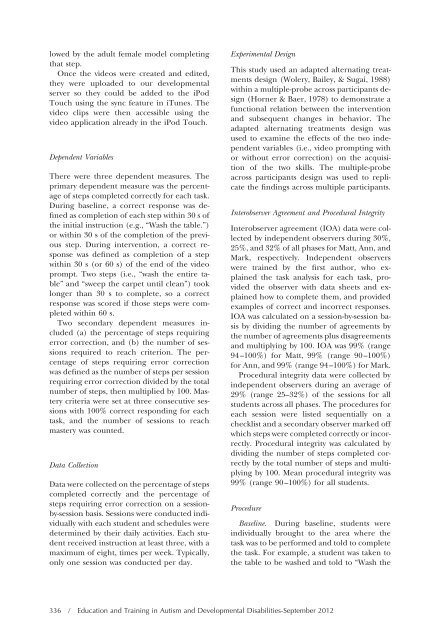etadd_47(3) - Division on Autism and Developmental Disabilities
etadd_47(3) - Division on Autism and Developmental Disabilities
etadd_47(3) - Division on Autism and Developmental Disabilities
Create successful ePaper yourself
Turn your PDF publications into a flip-book with our unique Google optimized e-Paper software.
lowed by the adult female model completing<br />
that step.<br />
Once the videos were created <strong>and</strong> edited,<br />
they were uploaded to our developmental<br />
server so they could be added to the iPod<br />
Touch using the sync feature in iTunes. The<br />
video clips were then accessible using the<br />
video applicati<strong>on</strong> already in the iPod Touch.<br />
Dependent Variables<br />
There were three dependent measures. The<br />
primary dependent measure was the percentage<br />
of steps completed correctly for each task.<br />
During baseline, a correct resp<strong>on</strong>se was defined<br />
as completi<strong>on</strong> of each step within 30 s of<br />
the initial instructi<strong>on</strong> (e.g., “Wash the table.”)<br />
or within 30 s of the completi<strong>on</strong> of the previous<br />
step. During interventi<strong>on</strong>, a correct resp<strong>on</strong>se<br />
was defined as completi<strong>on</strong> of a step<br />
within 30 s (or 60 s) of the end of the video<br />
prompt. Two steps (i.e., “wash the entire table”<br />
<strong>and</strong> “sweep the carpet until clean”) took<br />
l<strong>on</strong>ger than 30 s to complete, so a correct<br />
resp<strong>on</strong>se was scored if those steps were completed<br />
within 60 s.<br />
Two sec<strong>on</strong>dary dependent measures included<br />
(a) the percentage of steps requiring<br />
error correcti<strong>on</strong>, <strong>and</strong> (b) the number of sessi<strong>on</strong>s<br />
required to reach criteri<strong>on</strong>. The percentage<br />
of steps requiring error correcti<strong>on</strong><br />
was defined as the number of steps per sessi<strong>on</strong><br />
requiring error correcti<strong>on</strong> divided by the total<br />
number of steps, then multiplied by 100. Mastery<br />
criteria were set at three c<strong>on</strong>secutive sessi<strong>on</strong>s<br />
with 100% correct resp<strong>on</strong>ding for each<br />
task, <strong>and</strong> the number of sessi<strong>on</strong>s to reach<br />
mastery was counted.<br />
Data Collecti<strong>on</strong><br />
Data were collected <strong>on</strong> the percentage of steps<br />
completed correctly <strong>and</strong> the percentage of<br />
steps requiring error correcti<strong>on</strong> <strong>on</strong> a sessi<strong>on</strong>by-sessi<strong>on</strong><br />
basis. Sessi<strong>on</strong>s were c<strong>on</strong>ducted individually<br />
with each student <strong>and</strong> schedules were<br />
determined by their daily activities. Each student<br />
received instructi<strong>on</strong> at least three, with a<br />
maximum of eight, times per week. Typically,<br />
<strong>on</strong>ly <strong>on</strong>e sessi<strong>on</strong> was c<strong>on</strong>ducted per day.<br />
Experimental Design<br />
This study used an adapted alternating treatments<br />
design (Wolery, Bailey, & Sugai, 1988)<br />
within a multiple-probe across participants design<br />
(Horner & Baer, 1978) to dem<strong>on</strong>strate a<br />
functi<strong>on</strong>al relati<strong>on</strong> between the interventi<strong>on</strong><br />
<strong>and</strong> subsequent changes in behavior. The<br />
adapted alternating treatments design was<br />
used to examine the effects of the two independent<br />
variables (i.e., video prompting with<br />
or without error correcti<strong>on</strong>) <strong>on</strong> the acquisiti<strong>on</strong><br />
of the two skills. The multiple-probe<br />
across participants design was used to replicate<br />
the findings across multiple participants.<br />
Interobserver Agreement <strong>and</strong> Procedural Integrity<br />
Interobserver agreement (IOA) data were collected<br />
by independent observers during 30%,<br />
25%, <strong>and</strong> 32% of all phases for Matt, Ann, <strong>and</strong><br />
Mark, respectively. Independent observers<br />
were trained by the first author, who explained<br />
the task analysis for each task, provided<br />
the observer with data sheets <strong>and</strong> explained<br />
how to complete them, <strong>and</strong> provided<br />
examples of correct <strong>and</strong> incorrect resp<strong>on</strong>ses.<br />
IOA was calculated <strong>on</strong> a sessi<strong>on</strong>-by-sessi<strong>on</strong> basis<br />
by dividing the number of agreements by<br />
the number of agreements plus disagreements<br />
<strong>and</strong> multiplying by 100. IOA was 99% (range<br />
94–100%) for Matt, 99% (range 90–100%)<br />
for Ann, <strong>and</strong> 99% (range 94–100%) for Mark.<br />
Procedural integrity data were collected by<br />
independent observers during an average of<br />
29% (range 25–32%) of the sessi<strong>on</strong>s for all<br />
students across all phases. The procedures for<br />
each sessi<strong>on</strong> were listed sequentially <strong>on</strong> a<br />
checklist <strong>and</strong> a sec<strong>on</strong>dary observer marked off<br />
which steps were completed correctly or incorrectly.<br />
Procedural integrity was calculated by<br />
dividing the number of steps completed correctly<br />
by the total number of steps <strong>and</strong> multiplying<br />
by 100. Mean procedural integrity was<br />
99% (range 90–100%) for all students.<br />
Procedure<br />
Baseline. During baseline, students were<br />
individually brought to the area where the<br />
task was to be performed <strong>and</strong> told to complete<br />
the task. For example, a student was taken to<br />
the table to be washed <strong>and</strong> told to “Wash the<br />
336 / Educati<strong>on</strong> <strong>and</strong> Training in <strong>Autism</strong> <strong>and</strong> <strong>Developmental</strong> <strong>Disabilities</strong>-September 2012

















